Reaching for the stars

Petro oversees nearly 700 facilities and buildings across the Kennedy Space Center’s 144,000 acres. One of the most visible components of the space program is the 525-foot-high Vehicle Assembly Building, which is used to stack NASA’s largest rockets. NASA PHOTOS
Homegrown director takes over the helm of rejuvenated JFK space center
By Lucinda Coulter
As a child, Janet Petro and her family wended their way through palmettos on the dunes of Satellite Beach to see rockets blast off carrying Mercury and Gemini spacecraft. The pristine shore was near their home, miles from the John F. Kennedy Space Center where her father worked on those missions as an engineer.
Now nearly six decades later, Petro, 61, watches launches from the close range of Merritt Island and with the gravitas of a NASA leader. On June 30, she was appointed the center’s 11th director and the first woman to serve as such by NASA administrator Bill Nelson.
“I was deeply, deeply honored,” Petro says in an online video meeting with Space Coast Living. “That was my initial reaction, followed swiftly by, ‘Wow,’ being struck by this amazing responsibility that is now on my shoulders.”
Petro leads America’s premier multiuser spaceport during its largest expansion in missions since the shuttle program ended in 2011. In her center director’s welcome online, she notes that the “dreams of a nation” rooted in America’s space history are resurging as NASA plans to send humans back to the moon by 2024 and eventually to Mars and to continue launching commercial crew missions to the International Space Station.
If awed by the job’s enormity, she has already proven her mettle. As the center’s first woman deputy director for 14 years, she helped lead the senior management team that won the 2019 Samuel J. Heyman Service to America Management Excellence Medal. She received a President’s Distinguished Executive Award and the astronaut-selected Silver Snoopy Award for outstanding performance contributing to flight safety and mission success. In 2018, she was inducted into the Florida Women’s Hall of Fame, chosen by Gov. Rick Scott.
She helped transform the center’s facility to a multiuser spaceport with a wide variety of commercial and government partners able to use it. She coordinated efforts with the Federal Aviation Administration and Air Force to streamline government processes and support commercial use.
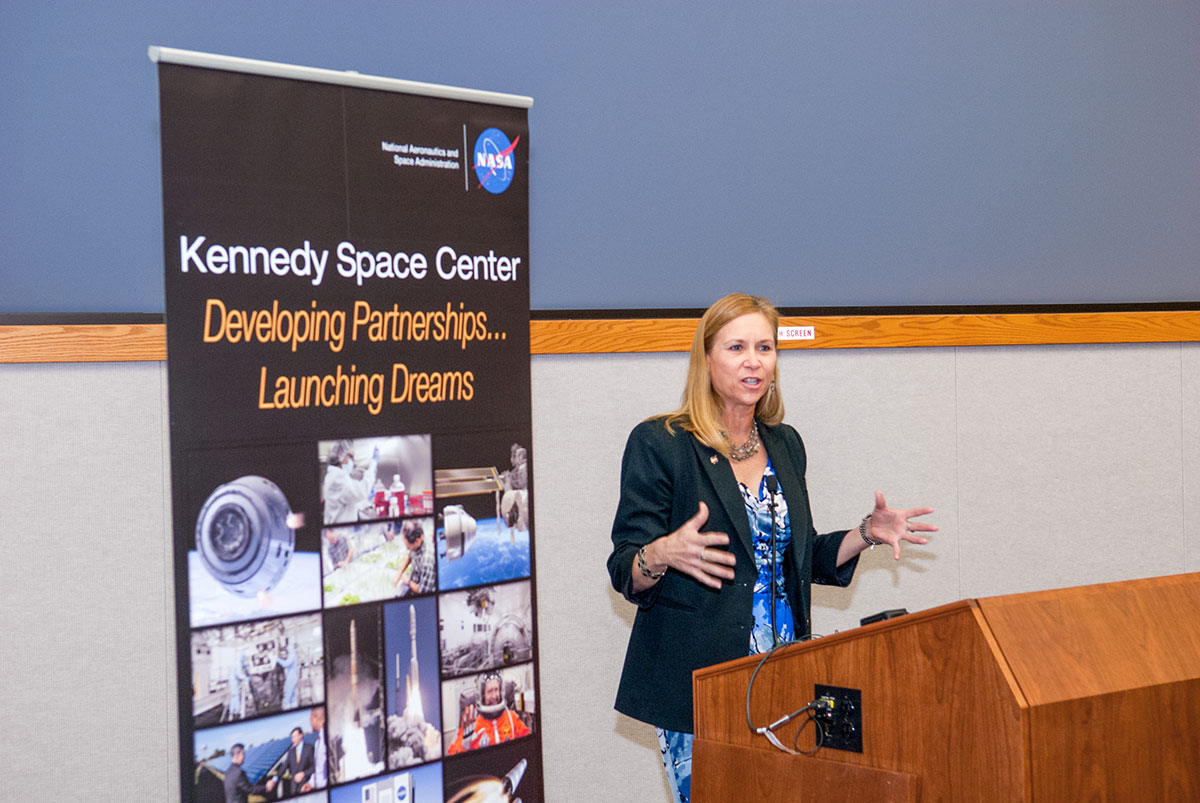
Petro speaks at a 2014 expo showcasing industrial vendors. NASA encourages collaboration with industry in part to accelerate regional economic growth on the Space Coast.
ENGINEERING A CAREER
Petro graduated from the U.S. Military Academy at West Point, with a bachelor’s degree in engineering in 1981. Her class was the second to accept women. As a commissioned officer, she flew Army helicopters in Germany for five years. Her work as an engineer started at Science Applications International Corp. and McDonnell Douglas Aerospace Corp. She holds a master’s in business administration from Boston University’s Metropolitan College.
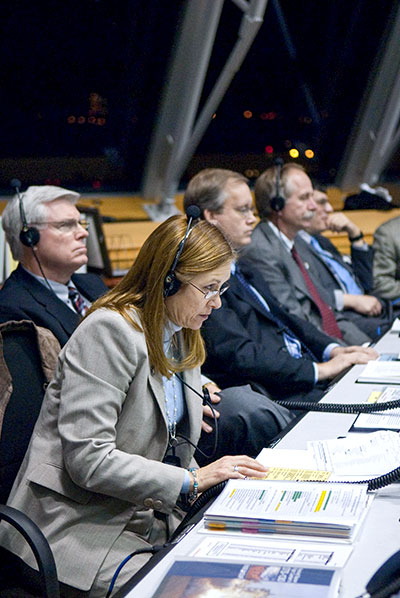
In the Launch Control Center, Petro and other managers monitor the countdown on Feb. 8, 2010, of space shuttle Endeavour’s last night flight. The STS 130 crewed mission carried a pressurized module that provided extra room for crew at the International Space Station.
Space exploration is part of her DNA, she says. Her family moved from Detroit, where Petro’s father worked at Chrysler Corp., to Satellite Beach in 1962. He worked on the Mercury, Gemini, Apollo and space shuttle programs as an engineer and, eventually, manager. She and her four siblings were inspired by America’s quests in space.
Now with her family close by, Petro resides at Indian Harbour Beach. Her son lives around the corner from her, her daughter is a senior majoring in engineering at Auburn University, and she enjoys her two grandchildren. Three of her siblings live on or near the Space Coast, and some have engineering careers. Her love of space found an even larger family at the Kennedy Space Center.
“What I love about the job is that there’s always something really significant and impactful going on,” Petro says, “whether it’s a launch or we’re breaking ground on another building or instituting a new business process to make ourselves more efficient. We’re greeting VIPs, senators and congressmen and getting to show off the place.”
She oversees a workforce of 7,300 civil and contract employees. For the ninth consecutive year, civil workers rated NASA as the best federal agency to work for, and the Kennedy Space Center holds that ranking among NASA’s 10 field centers. She is grateful for the 90 commercial partners and contractors, along with her dedicated team, “to meet the milestone,” she says.
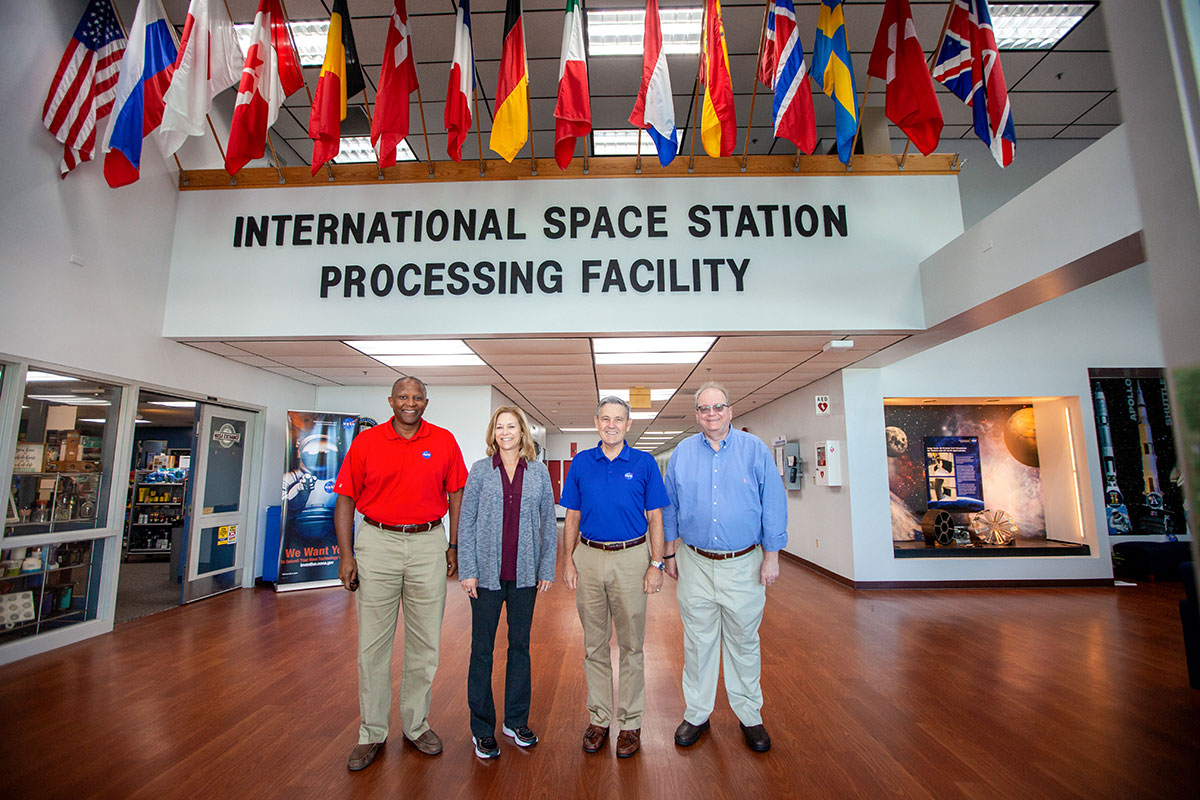
Leaders with the Kennedy Space Center and Sierra Nevada Corp. view the cargo module of the company’s reusable spaceplane, the Dream Chaser, at the Space Station Processing Facility at the spaceport in September 2019.
COMMITMENT TO NASA
Petro embraces NASA’s tenets — safety, integrity, teamwork, excellence and inclusion. Her support of a robust protocol set up to mitigate the coronavirus pandemic for safety exemplifies her commitment.
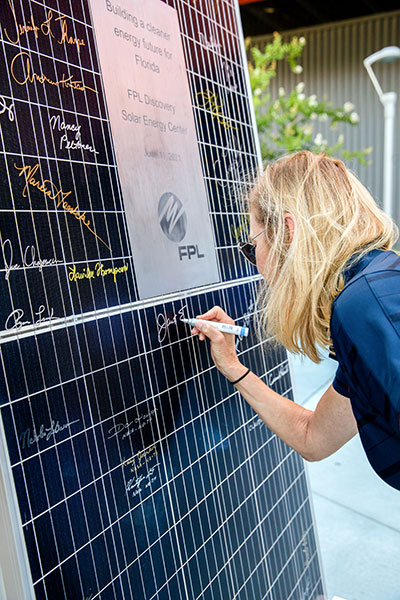
Petro signs a solar panel in June to commemorate Florida Power and Light’s 74.5-megawatt solar site, spanning 491 acres at the spaceport. The site sends energy to 15,000 homes for existing customers.
“I can’t say enough about the dedication and motivation of our workforce,” she says. “I think we do attract the best and the brightest and because we have such a cool mission, it’s not hard for people to want to come to work for NASA. You see it in the interns, the students that we host and people I run into in the grocery store.
“They don’t even know what position I have,” she says of shoppers who exclaim she’s a dignitary. “It’s just the fact that I work for NASA. It really resonates with people.”
The most dazzling to space aficionados — and the center’s most prominent — is the Artemis Exploration Ground Systems mission. It will send the first woman and first person of color to the moon and later carry astronauts to Mars. Artemis, the twin sister of Apollo in Greek myth, symbolizes America’s return to the moon, 50 years after the Apollo flights.
The Space Launch System, the most powerful rocket in the world, will carry humans and cargo to the moon from the cape. The Orion capsule, launching atop the SLS, will carry crew into lunar orbit.
Essential parts of the Artemis mission are the center’s launch pad, the mobile launcher, the crawler for delivering the rocket and Orion capsule to the launch pad, the Vertical Assembly Building and the processing facility where Orion was built. The first unmanned flight is set tentatively for Nov. 22, according to NASA.
“When that big, massive rocket lifts off, it’s going to be due to the hard work that our workforce at Kennedy Space Center under the Exploration Ground System Program is doing,” Petro says. “It’s an amazing honor we’ve been given, and we have got to deliver on that commitment and get that massive rocket delivered.”
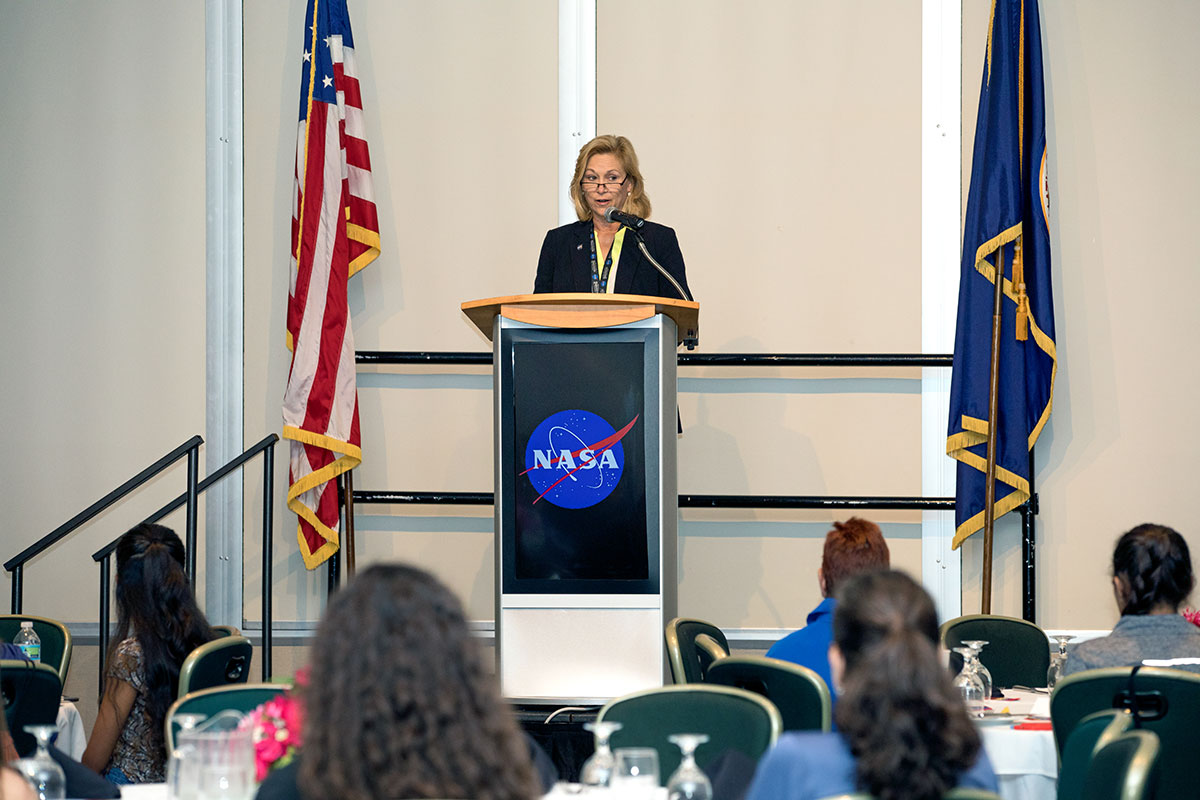
Petro describes details of her career path in engineering to students who competed in NASA’s eighth annual robotic mining competition at the Kennedy Space Center Visitor Complex in 2017.
BENEFICIAL MISSIONS
Another key mission, the Commercial Crew Program, streamlined travel to the space station, Petro says. In 2014, NASA chose SpaceX and Boeing for transports to the 22-year outpost and no longer hitches rides on the Russian Soyuz. The program allows more scientific research and exploration to be done on site. Opening low Earth orbits to commercial ventures is competitive and allows NASA to explore deeper into the solar system “with a benefit to all of humanity,” Petro notes, for example, in climate change.
“We’re super proud of that mission,” Petro says. “American rockets from American soil, and we have a redundant capacity for getting our great astronauts to the station.”
The Launch Services Program matches a commercial rocket with a payload to carry out scientific and robotic missions, “whether to Venus or the sun,” she says.
The center also prepares “all the payloads for delivery on cargo vehicles to the space station,” in the Exploration Research and Technology Program, Petro notes. Scientists conduct research to develop technology for the next generation of vehicles and sustainability for traveling in deep space.
“When you see astronauts on the space station eating lettuce, we’re the ones doing all the advanced research on that technology,” she explains. “When we go to Mars, we’re going to need to maintain good nutrition of the astronauts.”
International partnering is an essential part of the space station’s success and for heading to the moon and beyond.
“We’re going to need technology across the board to get there,” she says of the many countries that partner with NASA. “Space can be quite a unifying force.”
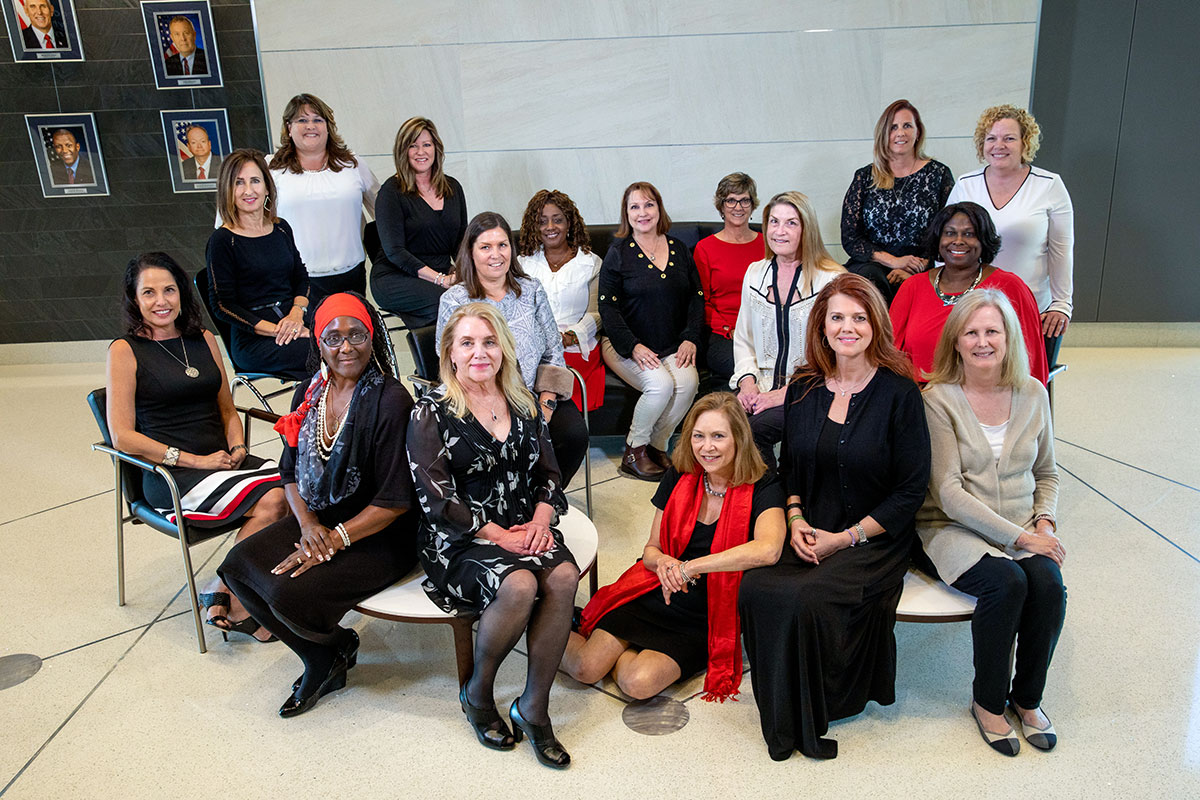
Senior managers at Kennedy Space Center gather to commemorate Women’s History Month in 2020. NASA supports an active outreach through speaking engagements, competitions and social media interaction for women employees to mentor youth, especially girls, interested in STEM careers, along with other fields.
ECONOMIC BOOST
The center’s ambitious programs have recharged Brevard County’s economy, local leaders say. Brian Baluta of the Economic Development Commission of Florida’s Space Coast notes that the nearly weekly launches at the cape mark a dramatic turnabout from 2011 when the shuttle program ended and the recession hit.
The presence of companies such as Lockheed Martin, Boeing, Blue Origin and WebOne Satellites has boosted the economy, especially in local manufacturing of components for space.
Lynda Weatherman, commission president and CEO, appreciates the relationship Petro nurtures with Brevard County’s business community.
“She is an excellent choice to take us to the next step,” Weatherman says.
Dale Ketcham, Space Florida’s vice president of governmental and external relations, is excited that NASA is heading back to the moon.
“There are a lot of changes to come, but change is life,” he says. “To have Janet, who certainly knows what she’s doing, is good.”
Petro thrived in the Space Age culture and tight-knit community of Satellite Beach.
“We were all very little, but it left its mark on us,” Petro says.
IDYLLIC CHILDHOOD
She cherishes her memory of the 1969 lunar landing. Then 9 years old, she watched Neil Armstrong step onto the moon and into space history forever on her family’s black-and-white screen television.
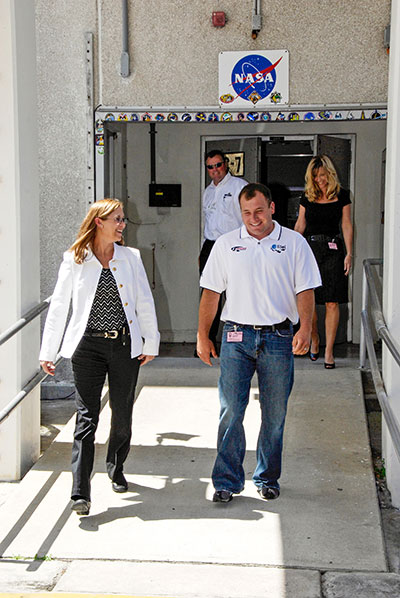
Petro and 2008 Daytona 500 winner Ryan Newman depart the Operations and Checkout Building as part of NASA’s and the iconic NASCAR race’s 50th anniversary events in 2008.
Her parents inspired her in a life of hard work, discipline and service. She attended Surfside Elementary, DeLaura Middle and Satellite High schools. She participated in Girl Scouts, band and sports. Veterans Day parades were fun.
“You didn’t get away with much because your neighbor was going to go tell your mom what you had done,” Petro says. “It was an idyllic place to grow up.”
She learned the importance of teamwork as the middle of five children and in softball, a sport she excelled in through college. In it she learned how to be resilient and face obstacles.
Petro credits West Point for a leadership code she applies every day. Long ago, she took to heart Gen. Douglas MacArthur’s farewell speech to the academy in his three words: “duty, honor, country.”
“His speech doesn’t just talk about where you are today,” she says. “It talks about where you need to strive to be.”
STEM CHAMPION
She advocates for women in science, math and engineering fields and has seen the center’s senior leadership increase to 50 percent female over decades.
“Persevere on your dream and don’t allow anybody to tell you ‘no,’ ” she advises in a May 2013 NASA video posted on YouTube. “Have confidence and pursue it, and you will reach your dream.”
The center heads a funded STEM outreach for college students, and Petro is passionate about providing opportunities to children in grades K-12. Girls should be encouraged to explore aptitudes long past middle school age, she says, noting that they often gain confidence to explore STEM fields as older teens. Her daughter, Hannah, for example, chose engineering late in high school before she enrolled at Auburn.
Petro is naturally inclined to share her love of learning, from books to her vision of space exploration.
“I’m always listening to a book, always,” she says, and often while walking her dog. Recently she listened to Jack London’s, The Call of the Wild, a classic she read as a child and shared with her grandchildren.
“Oh, my, gosh,” she recalls exclaiming to them. “You’ve got to read this book.”
As with reading, she invites people to ponder possibilities — from future space vacations in low orbits to space exploration as it impacts daily life. Space exploration requires so many skills beyond engineering, and satellite data informs myriads of day-to-day operations, she says.
“There’s something for everybody in space and for every occupation out there. I’m convinced of that.”
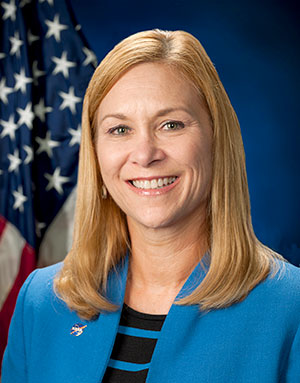
Janet Petro, Kennedy Space Center director.
Career highlights
1981 – Graduated from U.S. Military Academy at West Point, N.Y., with a bachelor’s degree in engineering.
1986 – Completed a five-year stint flying helicopters in Germany as a commissioned officer in the Army.
1986 – Began career as an engineer with various aerospace and defense industries, including SAIC and McDonnell Douglas Corp.
1988 – Graduated from Boston University’s Metropolitan College with master’s degree in business administration.
2007 – Appointed deputy director of the John F. Kennedy Space Center.
2018 – Inducted into the Florida Women’s Hall of Fame.
2019 – Awarded the Samuel J. Heyman Service to America Management Excellence Medal.
2021 – Appointed director of the Kennedy Space Center.




